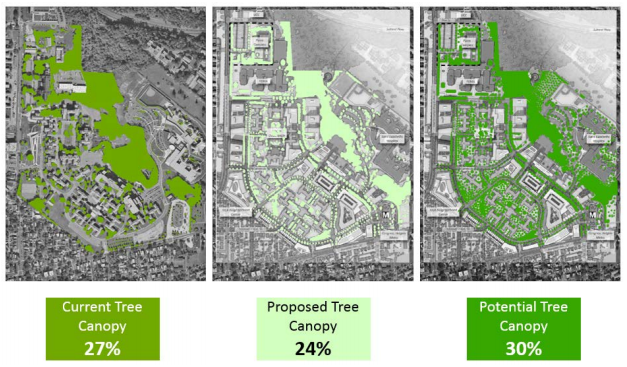Martine Combal
Attn.: St. Elizabeth’s East Redevelopment Public Comment
Office of the Deputy Mayor for Planning & Economic Development
1350 Pennsylvania Ave, NW Suite 317 Washington, DC 20004
February 2016
Re: Comments on the St. Elizabeth’s East Campus Redevelopment
Dear Martine Combal,
Casey Trees is a Washington DC-based nonprofit with a mission “to restore, enhance and protect the tree canopy of the nation’s capital.” To fulfill this mission, we plant trees; monitor the city’s tree canopy; and work with elected officials, planners, and residents to prioritize the District’s trees and to encourage tree planting on both public and private property.
We are dedicated to helping the District meet its 40 percent tree canopy goal by 2032. This goal is only achievable if existing trees are protected and the District adopts policies that grow the city’s urban forest.
We applaud Redbrick-Gragg Cardona’s commitment to preserving the site’s remarkable historic resources while creating a more connected, sustainable community. As one of the District’s largest redevelopment projects, this site has the opportunity to showcase large-scale green development as an example for future projects. However, the plan to build several mixed-use buildings east of 13th Street SE will remove significant dense forest. We believe that this development can and should support more trees to compensate for this significant loss of tree canopy.
We suggest the developer take the following steps:
• Protect existing trees (minimize tree removal and replace removed trees)
Protecting the site’s existing mature trees is essential to preserving the historic nature of St. Elizabeth’s East. In addition to the aesthetic, public health, and stormwater benefits, a strategically located mature tree conserves energy by cooling parking lots and buildings. Therefore, it is important to protect existing trees and their root systems to comply with the District Department of Transportation’s tree protection requirements (DWG NO. 608.10)
• Set a tree canopy goal
Casey Trees’ analysis shows the proposed design reduces the site’s canopy coverage from 27% to 24%. Further, there is potential for a 30% canopy within the proposed design (Figure 1). In order to demonstrate the project’s commitment to a sustainable, livable, and walkable community, the new development should set a tree canopy goal as one of its sustainability metrics. We suggest adopting a 30% tree canopy goal as part of this project.
• Incorporate advanced tree growth systems
To maximize canopy benefits, street trees need to grow quickly and have long, healthy lives. We recommend suspended sidewalks through the use of soil cells or structural soils as considered on page 50 of the Master Plan.
In addition, we support the use appropriate trees in bioretention systems. Trees uptake and filter rainwater before it enters the drainage system, reducing polluting overflows into the Potomac and Anacostia Rivers.
Thank you for the opportunity to comment. Casey Trees would be happy to work with you to achieve the suggested canopy goal, provide clarity on any of the above recommendations, or determine species selection for this site (see Casey Trees’ Urban Tree Selection Guide).
Sincerely,
Kristin D. Taddei
